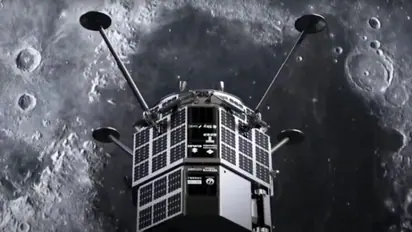Japanese spacecraft carrying UAE's Rashid rover makes unsuccessful landing; Report

Synopsis
If it had succeeded, it would have been the first commercial mission to successfully land on the moon.
Dubai: The HAKUTO-R Mission 1 (M1) lander, created by the Tokyo-based business ispace, was scheduled to touch down in the Moon's Atlas Crater on April 25 at about 16:40 (UTC). If it had succeeded, it would have been the first commercial mission to successfully land on the moon.
However, the ispace crew was unable to re-establish communication with the vehicle after the intended landing because it lost contact with it when it was about 90 metres above the lunar surface. Takeshi Hakamada, CEO of ispace, stated in a public statement, "We have to assume that we could not complete the landing."
Hours later, ispace said in a statement that there was a “high probability” M1 had made a crash landing on the Moon.
The company claims that its engineers are still determining exactly what went wrong. During its final approach, the 2.3-meter-tall lander was standing erect but was out of fuel. Data also reveals that the spacecraft's speed increased when it approached the lunar surface.
The United Arab Emirates' 50-centimeter-long Rashid rover, created by the Mohammed bin Rashid Space Centre in Dubai, was aboard the lander. With its cameras and probe, the rover sought to examine soil particles in the lunar environment and learn more about the lunar surface's geological characteristics. A multi-camera system made by Toronto, Canada-based Canadensys Aerospace and a two-wheeled robot created by the Japanese space agency, JAXA, was also on board.
On December 11, 2022, M1 was launched from Cape Canaveral, Florida, using a SpaceX Falcon 9 rocket. It began its lunar orbit on March 21 and, three weeks later, had ascended 100 kilometres above the Moon's surface. According to a statement from ispace, the mission has successfully completed 8 of its 10 goals. Data gathered during M1's lunar orbit and landing sequence, according to Hakamada, will provide information for ispace's subsequent Moon landing attempt, which is scheduled for 2024.
Check the Breaking News Today and Latest News from across India and around the world. Stay updated with the latest World News and global developments from politics to economy and current affairs. Get in-depth coverage of China News, Europe News, Pakistan News, and South Asia News, along with top headlines from the UK and US. Follow expert analysis, international trends, and breaking updates from around the globe. Download the Asianet News Official App from the Android Play Store and iPhone App Store for accurate and timely news updates anytime, anywhere.